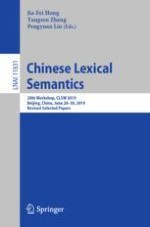2020 | Buch
Chinese Lexical Semantics
20th Workshop, CLSW 2019, Beijing, China, June 28–30, 2019, Revised Selected Papers
herausgegeben von: Jia-Fei Hong, Yangsen Zhang, Prof. Dr. Pengyuan Liu
Verlag: Springer International Publishing
Buchreihe : Lecture Notes in Computer Science
